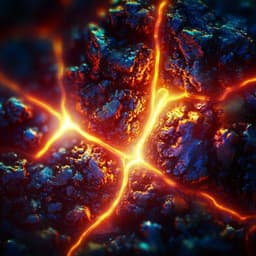
Physics
Circuit Implementation of a Four-Dimensional Topological Insulator
Y. Wang, H. M. Price, et al.
This groundbreaking research by You Wang, Hannah M. Price, Baile Zhang, and Y. D. Chong unveils a four-dimensional topological insulator crafted through electric circuits, revealing topological surface states associated with a non-zero second Chern number. Explore the unprecedented realm of high-dimensional topological models demonstrated in this study!
Playback language: English
Introduction
Topological insulators are materials exhibiting insulating bulk behavior but supporting protected surface states due to non-trivial topological features of their bulk band structures. These materials are classified based on symmetry and dimensionality, with each class possessing unique properties. Two-dimensional Quantum Hall (2DQH) phases, for instance, exhibit unidirectional edge states, while three-dimensional (3D) topological insulators based on spin-orbit coupling feature surface states behaving as massless 2D Dirac particles. The theoretical classification of topological insulators includes high-dimensional phases, notably four-dimensional Quantum Hall (4DQH) phases, characterized by a 4D topological invariant – the second Chern number. These phases are predicted to have richer phenomenology than 2DQH phases. Realizing these high-dimensional phases is challenging because electrons are confined to three spatial dimensions. Recent advancements in engineered systems such as cold atom lattices, photonic structures, acoustic and mechanical resonators, and electric circuits have opened avenues to simulate topological phases that are difficult to achieve in natural materials. While previous work demonstrated topological pumps mapping 4D lattice states onto lower dimensions, a direct experimental realization of a 4D topological insulator with protected surface states on a 3D surface was lacking until this study. This research focuses on implementing a 4DQH phase using electric circuits, leveraging their inherent ability to explicitly construct high-dimensional lattice structures through lumped element interconnections. The study experimentally implements a 4D lattice representing the first realization of a Class A1 topological insulator, a class that lacks lower-dimensional counterparts. Class A1, encompassing time-reversal (T) symmetric, spinless systems without special spatial symmetries, is topologically trivial in one to three dimensions. The second Chern number, unlike the first Chern number which requires T-breaking, is relevant for 4DQH phases and does not require T breaking. Therefore, a Class A1 topological insulator necessitates at least four dimensions. The researchers utilize a theoretical 4D lattice model exhibiting a non-zero second Chern number with vanishing first Chern numbers, ensuring the observed topological surface states are intrinsically linked to 4D topology, independent of lower-dimensional invariants. This approach contrasts with alternative methods employing synthetic dimensions or adiabatic topological pumping, which map high-dimensional models onto lower-dimensional setups, often limiting the exploration to specific quasi-static solutions or relying on non-zero first Chern numbers. The present work utilizes electric circuits to achieve a genuine high-dimensional lattice, avoiding these limitations.
Literature Review
The paper extensively reviews the existing literature on topological insulators, highlighting the classification of topological phases based on symmetry and dimensionality (Altland & Zirnbauer, 1997; Kitaev, 2009; Schnyder et al., 2008; Ryu et al., 2010; Chiu et al., 2016). It discusses previous work on the 2DQH effect (Klitzing et al., 1980) and the theoretical framework for 4DQH phases (Avron et al., 1988; Fröhlich & Pedrini, 2000; Zhang, 2001; Sugawa et al., 2018). The review covers various platforms used to implement topological phases, including cold atom lattices (Cooper et al., 2019), photonic structures (Ozawa et al., 2019), acoustic and mechanical resonators (Yang et al., 2015; Huber, 2016), and electric circuits (Ningyuan et al., 2015; Albert et al., 2015; Hadad et al., 2018; Lee et al., 2018; Imhof et al., 2018; Luo et al., 2018; Ezawa, 2018; Wang et al., 2019; Lu et al., 2019; Serra-Garcia et al., 2019; Helbig et al., 2019; Hofmann et al., 2019). Particular attention is given to previous attempts at simulating 4D systems using topological pumps (Thouless, 1983; Kraus et al., 2013; Petrides et al., 2018; Lee et al., 2018; Lohse et al., 2018; Zilberberg et al., 2018), and the use of synthetic dimensions (Boada et al., 2012; Celi et al., 2014; Price et al., 2015; Mancini et al., 2015; Stuhl et al., 2015; Ozawa et al., 2016; Price et al., 2016; Yuan et al., 2016; Ozawa & Carusotto, 2017; Price et al., 2017; Yuan et al., 2018; Lustig et al., 2019; Ozawa & Price, 2019; Dutt et al., 2020). The authors emphasize the novelty of their approach, which directly constructs a 4D lattice using electric circuits, unlike previous methods that relied on mapping to lower dimensions or using synthetic dimensions.
Methodology
The study employs a 4D lattice model proposed by one of the authors (Price, 2020), which exhibits a non-zero second Chern number with vanishing first Chern numbers. This model is realized using electric circuits, where each site in the tight-binding model corresponds to a node in the circuit. The mass term in the model is represented by a circuit component's conductance connecting the node to ground, and hoppings are represented by conductances connecting different nodes. Capacitances and inductances in the circuit represent positive and negative hoppings, respectively. A key aspect is the implementation of a 4D lattice structure using circuit connections. This is achieved by carefully designing the capacitive and inductive connections between different circuit nodes. The authors employ a finite 4D lattice with specific dimensions, implementing periodic boundary conditions in two dimensions to mitigate finite-size effects and focus on the region of momentum space where gap closing occurs during topological transitions. The total number of sites in the lattice is 144, with 16 considered bulk sites and 128 surface sites. The relationship between the circuit elements and the tight-binding Hamiltonian is established using Kirchhoff's law and the definition of impedance. Impedance measurements, equivalent to obtaining the local density of states (LDOS), are used to probe the system. Specifically, the real part of the impedance between a node and ground, measured at a specific frequency, provides a measure of the LDOS at a target energy. The mass parameter *m* in the model is controlled by adjusting the circuit component values. The researchers fabricate a series of circuits with varying *m* and energy *E*, performing impedance measurements to determine the LDOS. The experimental setup involves a network of interconnected printed circuit boards, each representing a section of the 4D lattice. The circuit components were chosen to match the theoretical model at a reference frequency. The authors also conduct circuit simulations using ngspice, a free circuit simulator, to verify the experimental results. The simulations account for the resistance of the circuit components and incorporate 10% disorder in capacitance and inductance values to reflect real-world variability. The simulations provide impedance values in good agreement with the experimental findings.
Key Findings
The experimental results demonstrate the successful implementation of a 4D topological insulator in the circuit. The band diagram calculated for the infinite 4D lattice shows a topologically nontrivial bandgap for |m| < 6, hosting topological surface states. The finite-size 144-site lattice shows a similar band structure, although the gap closing is shifted due to finite-size effects. Measurements of the LDOS using impedance measurements reveal a strong enhancement of LDOS at the surface compared to the bulk in the topologically nontrivial bandgap, consistent with the presence of topological surface states. This enhanced surface response is observed over a frequency range corresponding to the bulk bandgap. As the mass parameter *m* is increased beyond the critical value, the gap closes, and the surface and bulk LDOS become similar. The ratio of mean surface LDOS to mean bulk LDOS sharply decreases as *m* increases, exhibiting a clear distinction between the 4DQH phase and the conventional insulator phase. The frequency dependence of the LDOS further validates the findings, showing a strong surface response at the reference frequency in the 4DQH phase and a diminishing frequency-dependent feature as *m* increases. The experimental results agree well with the circuit simulations, which also include modeling of disorder in the circuit components. The observed surface states cannot be explained by the first Chern number because the circuit design is time-reversal symmetric, providing strong evidence for the presence of a non-trivial second Chern number and a genuinely 4D topological phase.
Discussion
The successful implementation of a 4D topological insulator using electric circuits addresses the longstanding challenge of experimentally realizing high-dimensional topological phases. The study provides the first experimental demonstration of a topological lattice with a true 4D structure, avoiding the limitations of previous approaches based on synthetic dimensions or topological pumps. The observation of topological surface states with a non-zero second Chern number and vanishing first Chern numbers highlights the unique properties of this 4D system. The excellent agreement between experimental results and circuit simulations further validates the findings. The work establishes electric circuits as a powerful platform for exploring exotic topological phases that are inaccessible using traditional materials.
Conclusion
This research successfully implemented a 4D topological insulator using electric circuits, demonstrating a genuine 4D topological lattice for the first time. The observed topological surface states are attributed to a non-trivial second Chern number, confirming the existence of a Class A1 topological insulator. The study validates the use of electric circuits as a versatile tool for studying high-dimensional topological phenomena. Future research could focus on detailed investigations of the 3D surface states, predicted to exhibit unique features not found in lower-dimensional systems, such as robust isolated Weyl points of the same chirality. This approach holds promise for exploring other previously inaccessible topological phases and expands the possibilities of topological quantum matter research.
Limitations
The study utilizes a finite-size lattice, which introduces finite-size effects, notably a shift in the gap-closing point. While periodic boundary conditions were employed to mitigate these effects, they might still influence the precise location of the topological phase transition. The circuit simulations, although comprehensive, do not fully account for all sources of resistance in the experimental setup, which could introduce minor discrepancies between the simulation and experimental results. The focus is primarily on the overall surface-to-bulk LDOS ratio; more detailed analysis of the surface states' properties could provide deeper insights into the 4D topological nature of the system.
Related Publications
Explore these studies to deepen your understanding of the subject.







